Marine Phytoplankton: A Study of Morphology, Evolution, and Ecology
VerifiedAdded on 2022/08/19
|7
|1535
|10
Report
AI Summary
This report provides a comprehensive overview of marine phytoplankton, exploring their biology, morphology, evolutionary adaptations, and ecological roles. It examines the classification of phytoplankton into dinoflagellates and diatoms, and delves into their morphology, highlighting the influence of adaptive strategies on size and shape variations. The report further investigates the evolutionary biology of phytoplankton, including their 'bloom-and-bust' life strategies and the impact of environmental changes like ocean acidification. Additionally, it discusses the phylogenetics and physiology of various phytoplankton species, analyzing their genetic relationships. The study also touches upon the ecology of marine phytoplankton, emphasizing their diversity and distribution in aquatic environments and concludes by highlighting the importance of studying these organisms in comparative biology.
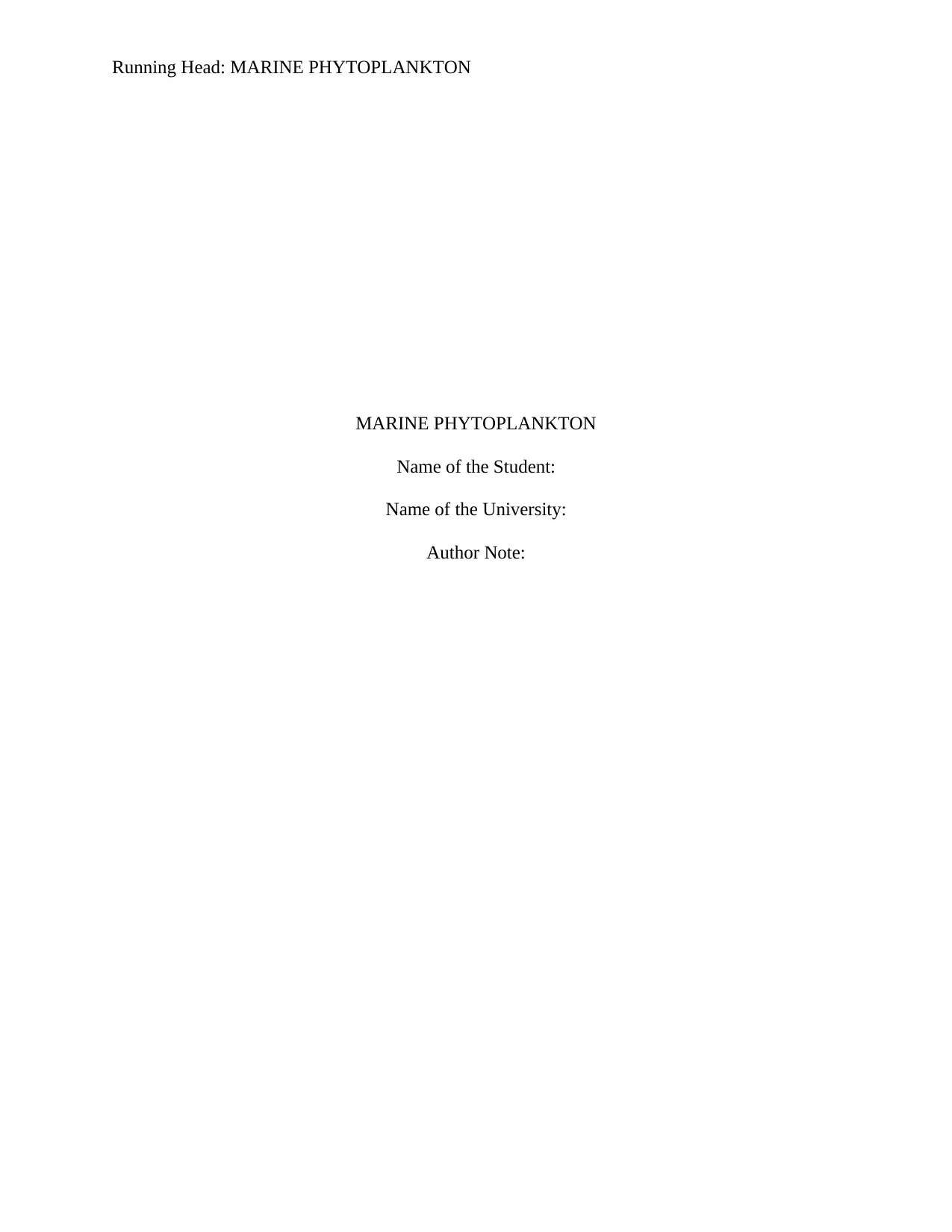
Running Head: MARINE PHYTOPLANKTON
MARINE PHYTOPLANKTON
Name of the Student:
Name of the University:
Author Note:
MARINE PHYTOPLANKTON
Name of the Student:
Name of the University:
Author Note:
Paraphrase This Document
Need a fresh take? Get an instant paraphrase of this document with our AI Paraphraser
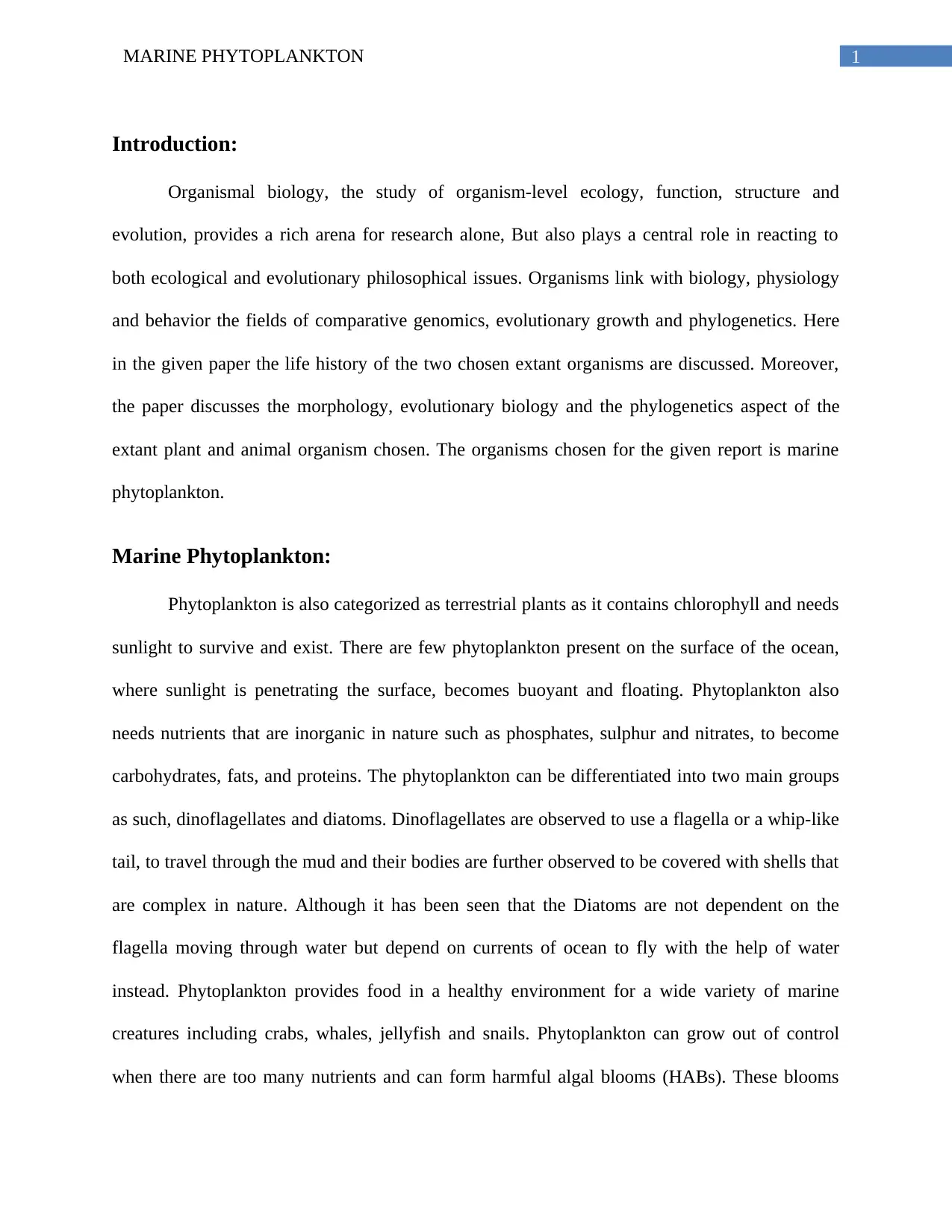
1MARINE PHYTOPLANKTON
Introduction:
Organismal biology, the study of organism-level ecology, function, structure and
evolution, provides a rich arena for research alone, But also plays a central role in reacting to
both ecological and evolutionary philosophical issues. Organisms link with biology, physiology
and behavior the fields of comparative genomics, evolutionary growth and phylogenetics. Here
in the given paper the life history of the two chosen extant organisms are discussed. Moreover,
the paper discusses the morphology, evolutionary biology and the phylogenetics aspect of the
extant plant and animal organism chosen. The organisms chosen for the given report is marine
phytoplankton.
Marine Phytoplankton:
Phytoplankton is also categorized as terrestrial plants as it contains chlorophyll and needs
sunlight to survive and exist. There are few phytoplankton present on the surface of the ocean,
where sunlight is penetrating the surface, becomes buoyant and floating. Phytoplankton also
needs nutrients that are inorganic in nature such as phosphates, sulphur and nitrates, to become
carbohydrates, fats, and proteins. The phytoplankton can be differentiated into two main groups
as such, dinoflagellates and diatoms. Dinoflagellates are observed to use a flagella or a whip-like
tail, to travel through the mud and their bodies are further observed to be covered with shells that
are complex in nature. Although it has been seen that the Diatoms are not dependent on the
flagella moving through water but depend on currents of ocean to fly with the help of water
instead. Phytoplankton provides food in a healthy environment for a wide variety of marine
creatures including crabs, whales, jellyfish and snails. Phytoplankton can grow out of control
when there are too many nutrients and can form harmful algal blooms (HABs). These blooms
Introduction:
Organismal biology, the study of organism-level ecology, function, structure and
evolution, provides a rich arena for research alone, But also plays a central role in reacting to
both ecological and evolutionary philosophical issues. Organisms link with biology, physiology
and behavior the fields of comparative genomics, evolutionary growth and phylogenetics. Here
in the given paper the life history of the two chosen extant organisms are discussed. Moreover,
the paper discusses the morphology, evolutionary biology and the phylogenetics aspect of the
extant plant and animal organism chosen. The organisms chosen for the given report is marine
phytoplankton.
Marine Phytoplankton:
Phytoplankton is also categorized as terrestrial plants as it contains chlorophyll and needs
sunlight to survive and exist. There are few phytoplankton present on the surface of the ocean,
where sunlight is penetrating the surface, becomes buoyant and floating. Phytoplankton also
needs nutrients that are inorganic in nature such as phosphates, sulphur and nitrates, to become
carbohydrates, fats, and proteins. The phytoplankton can be differentiated into two main groups
as such, dinoflagellates and diatoms. Dinoflagellates are observed to use a flagella or a whip-like
tail, to travel through the mud and their bodies are further observed to be covered with shells that
are complex in nature. Although it has been seen that the Diatoms are not dependent on the
flagella moving through water but depend on currents of ocean to fly with the help of water
instead. Phytoplankton provides food in a healthy environment for a wide variety of marine
creatures including crabs, whales, jellyfish and snails. Phytoplankton can grow out of control
when there are too many nutrients and can form harmful algal blooms (HABs). These blooms
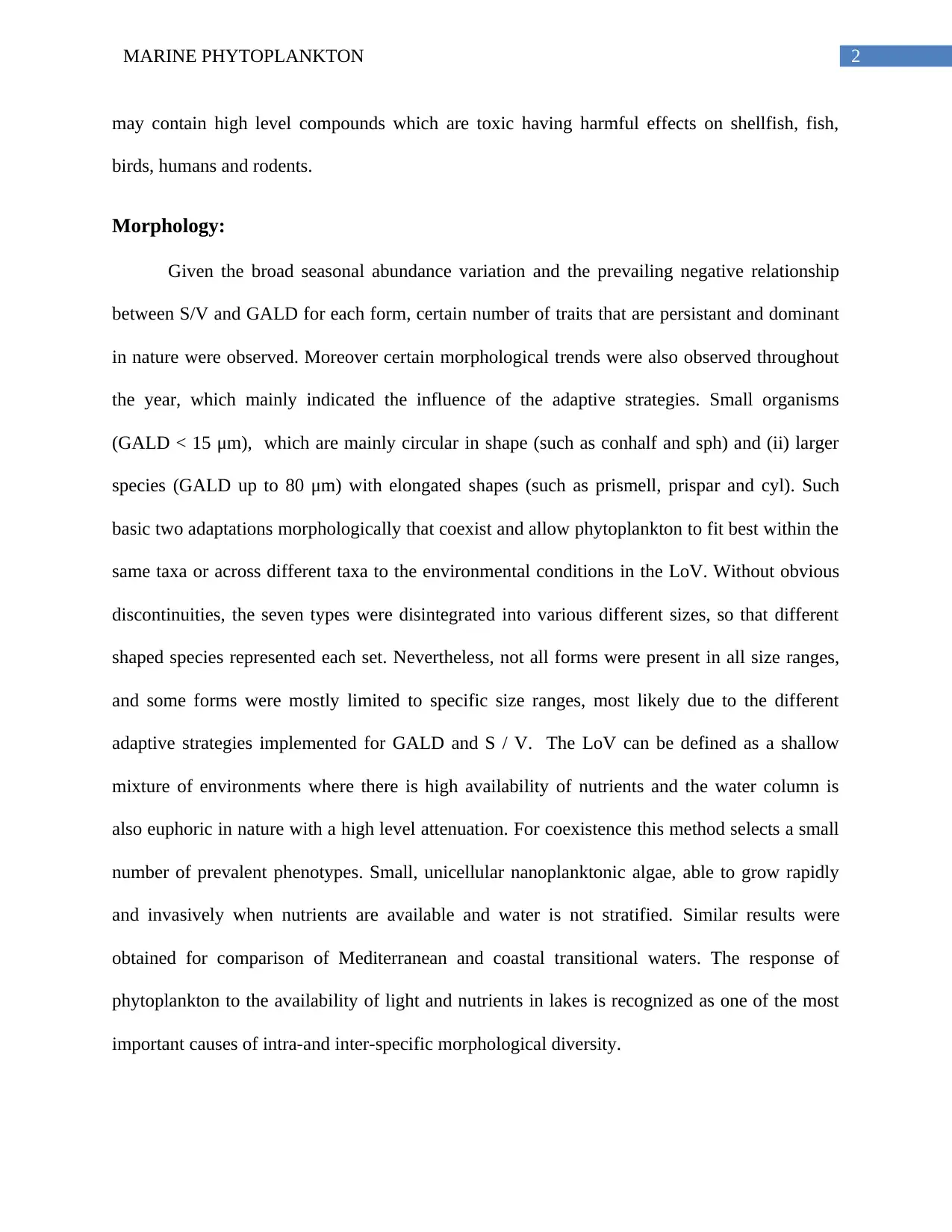
2MARINE PHYTOPLANKTON
may contain high level compounds which are toxic having harmful effects on shellfish, fish,
birds, humans and rodents.
Morphology:
Given the broad seasonal abundance variation and the prevailing negative relationship
between S/V and GALD for each form, certain number of traits that are persistant and dominant
in nature were observed. Moreover certain morphological trends were also observed throughout
the year, which mainly indicated the influence of the adaptive strategies. Small organisms
(GALD < 15 μm), which are mainly circular in shape (such as conhalf and sph) and (ii) larger
species (GALD up to 80 μm) with elongated shapes (such as prismell, prispar and cyl). Such
basic two adaptations morphologically that coexist and allow phytoplankton to fit best within the
same taxa or across different taxa to the environmental conditions in the LoV. Without obvious
discontinuities, the seven types were disintegrated into various different sizes, so that different
shaped species represented each set. Nevertheless, not all forms were present in all size ranges,
and some forms were mostly limited to specific size ranges, most likely due to the different
adaptive strategies implemented for GALD and S / V. The LoV can be defined as a shallow
mixture of environments where there is high availability of nutrients and the water column is
also euphoric in nature with a high level attenuation. For coexistence this method selects a small
number of prevalent phenotypes. Small, unicellular nanoplanktonic algae, able to grow rapidly
and invasively when nutrients are available and water is not stratified. Similar results were
obtained for comparison of Mediterranean and coastal transitional waters. The response of
phytoplankton to the availability of light and nutrients in lakes is recognized as one of the most
important causes of intra-and inter-specific morphological diversity.
may contain high level compounds which are toxic having harmful effects on shellfish, fish,
birds, humans and rodents.
Morphology:
Given the broad seasonal abundance variation and the prevailing negative relationship
between S/V and GALD for each form, certain number of traits that are persistant and dominant
in nature were observed. Moreover certain morphological trends were also observed throughout
the year, which mainly indicated the influence of the adaptive strategies. Small organisms
(GALD < 15 μm), which are mainly circular in shape (such as conhalf and sph) and (ii) larger
species (GALD up to 80 μm) with elongated shapes (such as prismell, prispar and cyl). Such
basic two adaptations morphologically that coexist and allow phytoplankton to fit best within the
same taxa or across different taxa to the environmental conditions in the LoV. Without obvious
discontinuities, the seven types were disintegrated into various different sizes, so that different
shaped species represented each set. Nevertheless, not all forms were present in all size ranges,
and some forms were mostly limited to specific size ranges, most likely due to the different
adaptive strategies implemented for GALD and S / V. The LoV can be defined as a shallow
mixture of environments where there is high availability of nutrients and the water column is
also euphoric in nature with a high level attenuation. For coexistence this method selects a small
number of prevalent phenotypes. Small, unicellular nanoplanktonic algae, able to grow rapidly
and invasively when nutrients are available and water is not stratified. Similar results were
obtained for comparison of Mediterranean and coastal transitional waters. The response of
phytoplankton to the availability of light and nutrients in lakes is recognized as one of the most
important causes of intra-and inter-specific morphological diversity.
You're viewing a preview
Unlock full access by subscribing today!
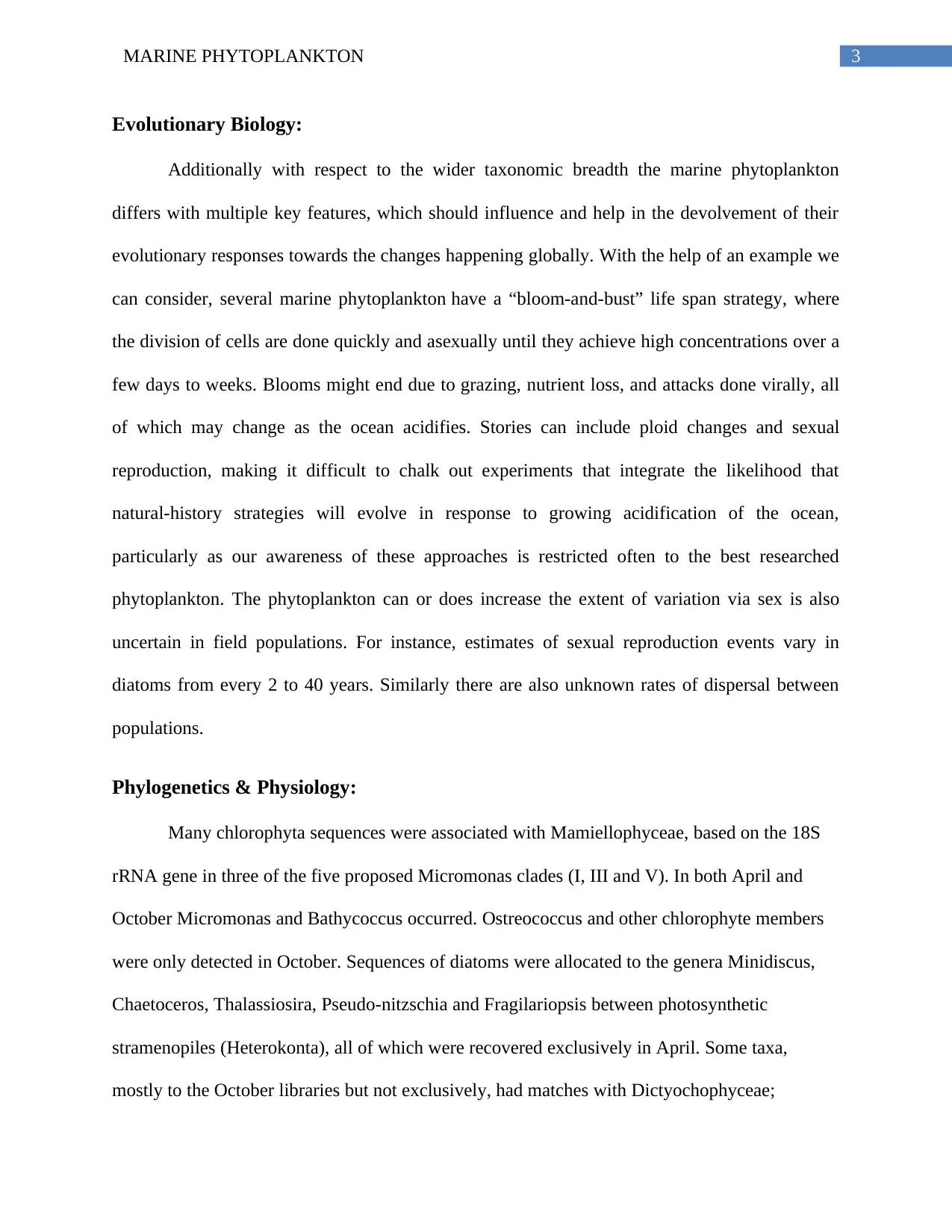
3MARINE PHYTOPLANKTON
Evolutionary Biology:
Additionally with respect to the wider taxonomic breadth the marine phytoplankton
differs with multiple key features, which should influence and help in the devolvement of their
evolutionary responses towards the changes happening globally. With the help of an example we
can consider, several marine phytoplankton have a “bloom-and-bust” life span strategy, where
the division of cells are done quickly and asexually until they achieve high concentrations over a
few days to weeks. Blooms might end due to grazing, nutrient loss, and attacks done virally, all
of which may change as the ocean acidifies. Stories can include ploid changes and sexual
reproduction, making it difficult to chalk out experiments that integrate the likelihood that
natural-history strategies will evolve in response to growing acidification of the ocean,
particularly as our awareness of these approaches is restricted often to the best researched
phytoplankton. The phytoplankton can or does increase the extent of variation via sex is also
uncertain in field populations. For instance, estimates of sexual reproduction events vary in
diatoms from every 2 to 40 years. Similarly there are also unknown rates of dispersal between
populations.
Phylogenetics & Physiology:
Many chlorophyta sequences were associated with Mamiellophyceae, based on the 18S
rRNA gene in three of the five proposed Micromonas clades (I, III and V). In both April and
October Micromonas and Bathycoccus occurred. Ostreococcus and other chlorophyte members
were only detected in October. Sequences of diatoms were allocated to the genera Minidiscus,
Chaetoceros, Thalassiosira, Pseudo-nitzschia and Fragilariopsis between photosynthetic
stramenopiles (Heterokonta), all of which were recovered exclusively in April. Some taxa,
mostly to the October libraries but not exclusively, had matches with Dictyochophyceae;
Evolutionary Biology:
Additionally with respect to the wider taxonomic breadth the marine phytoplankton
differs with multiple key features, which should influence and help in the devolvement of their
evolutionary responses towards the changes happening globally. With the help of an example we
can consider, several marine phytoplankton have a “bloom-and-bust” life span strategy, where
the division of cells are done quickly and asexually until they achieve high concentrations over a
few days to weeks. Blooms might end due to grazing, nutrient loss, and attacks done virally, all
of which may change as the ocean acidifies. Stories can include ploid changes and sexual
reproduction, making it difficult to chalk out experiments that integrate the likelihood that
natural-history strategies will evolve in response to growing acidification of the ocean,
particularly as our awareness of these approaches is restricted often to the best researched
phytoplankton. The phytoplankton can or does increase the extent of variation via sex is also
uncertain in field populations. For instance, estimates of sexual reproduction events vary in
diatoms from every 2 to 40 years. Similarly there are also unknown rates of dispersal between
populations.
Phylogenetics & Physiology:
Many chlorophyta sequences were associated with Mamiellophyceae, based on the 18S
rRNA gene in three of the five proposed Micromonas clades (I, III and V). In both April and
October Micromonas and Bathycoccus occurred. Ostreococcus and other chlorophyte members
were only detected in October. Sequences of diatoms were allocated to the genera Minidiscus,
Chaetoceros, Thalassiosira, Pseudo-nitzschia and Fragilariopsis between photosynthetic
stramenopiles (Heterokonta), all of which were recovered exclusively in April. Some taxa,
mostly to the October libraries but not exclusively, had matches with Dictyochophyceae;
Paraphrase This Document
Need a fresh take? Get an instant paraphrase of this document with our AI Paraphraser
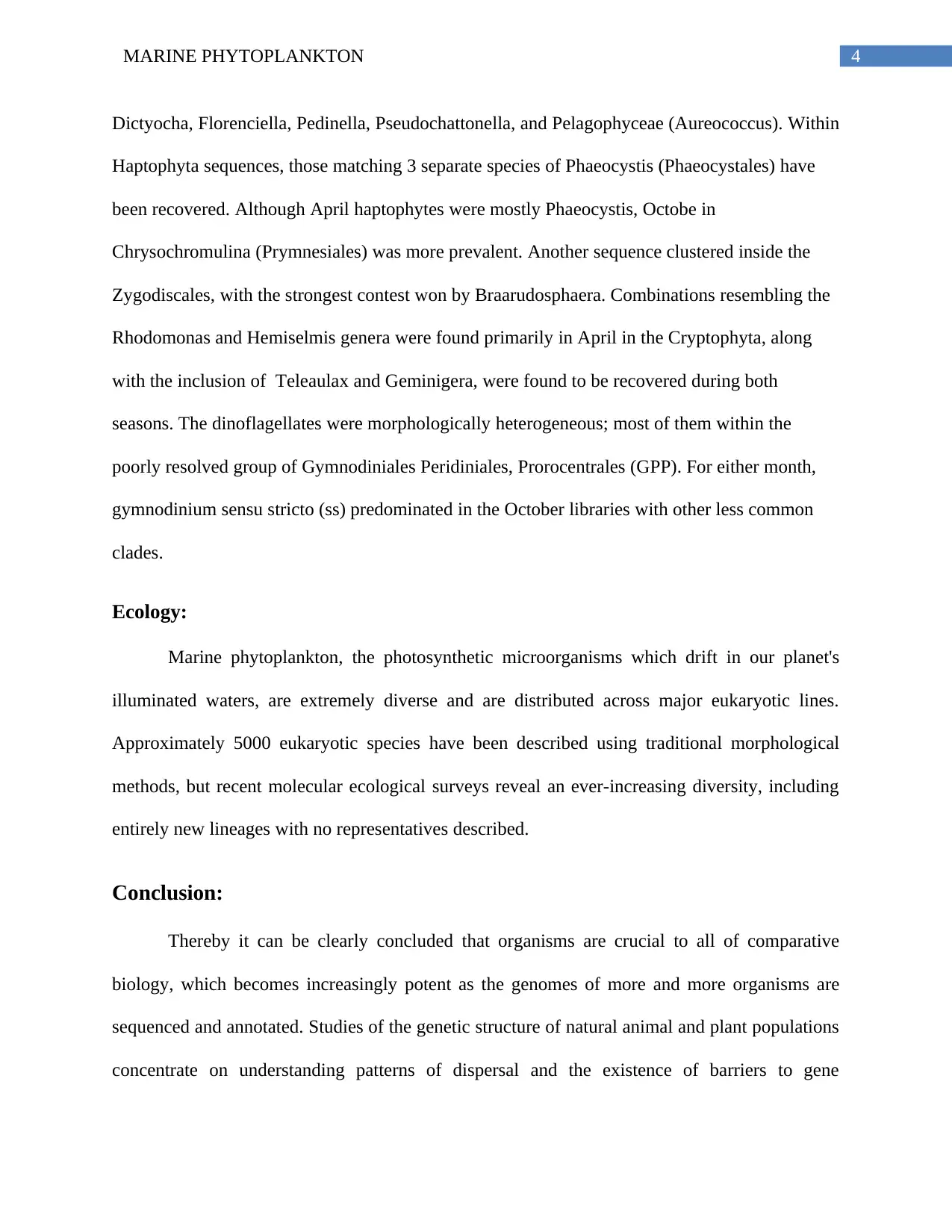
4MARINE PHYTOPLANKTON
Dictyocha, Florenciella, Pedinella, Pseudochattonella, and Pelagophyceae (Aureococcus). Within
Haptophyta sequences, those matching 3 separate species of Phaeocystis (Phaeocystales) have
been recovered. Although April haptophytes were mostly Phaeocystis, Octobe in
Chrysochromulina (Prymnesiales) was more prevalent. Another sequence clustered inside the
Zygodiscales, with the strongest contest won by Braarudosphaera. Combinations resembling the
Rhodomonas and Hemiselmis genera were found primarily in April in the Cryptophyta, along
with the inclusion of Teleaulax and Geminigera, were found to be recovered during both
seasons. The dinoflagellates were morphologically heterogeneous; most of them within the
poorly resolved group of Gymnodiniales Peridiniales, Prorocentrales (GPP). For either month,
gymnodinium sensu stricto (ss) predominated in the October libraries with other less common
clades.
Ecology:
Marine phytoplankton, the photosynthetic microorganisms which drift in our planet's
illuminated waters, are extremely diverse and are distributed across major eukaryotic lines.
Approximately 5000 eukaryotic species have been described using traditional morphological
methods, but recent molecular ecological surveys reveal an ever-increasing diversity, including
entirely new lineages with no representatives described.
Conclusion:
Thereby it can be clearly concluded that organisms are crucial to all of comparative
biology, which becomes increasingly potent as the genomes of more and more organisms are
sequenced and annotated. Studies of the genetic structure of natural animal and plant populations
concentrate on understanding patterns of dispersal and the existence of barriers to gene
Dictyocha, Florenciella, Pedinella, Pseudochattonella, and Pelagophyceae (Aureococcus). Within
Haptophyta sequences, those matching 3 separate species of Phaeocystis (Phaeocystales) have
been recovered. Although April haptophytes were mostly Phaeocystis, Octobe in
Chrysochromulina (Prymnesiales) was more prevalent. Another sequence clustered inside the
Zygodiscales, with the strongest contest won by Braarudosphaera. Combinations resembling the
Rhodomonas and Hemiselmis genera were found primarily in April in the Cryptophyta, along
with the inclusion of Teleaulax and Geminigera, were found to be recovered during both
seasons. The dinoflagellates were morphologically heterogeneous; most of them within the
poorly resolved group of Gymnodiniales Peridiniales, Prorocentrales (GPP). For either month,
gymnodinium sensu stricto (ss) predominated in the October libraries with other less common
clades.
Ecology:
Marine phytoplankton, the photosynthetic microorganisms which drift in our planet's
illuminated waters, are extremely diverse and are distributed across major eukaryotic lines.
Approximately 5000 eukaryotic species have been described using traditional morphological
methods, but recent molecular ecological surveys reveal an ever-increasing diversity, including
entirely new lineages with no representatives described.
Conclusion:
Thereby it can be clearly concluded that organisms are crucial to all of comparative
biology, which becomes increasingly potent as the genomes of more and more organisms are
sequenced and annotated. Studies of the genetic structure of natural animal and plant populations
concentrate on understanding patterns of dispersal and the existence of barriers to gene

5MARINE PHYTOPLANKTON
exchange; together with ecology and behavioral studies, these studies allow for detailed analysis
of how genotype, phenotype, and climate interact in order to decide evolutionary trajectories.
exchange; together with ecology and behavioral studies, these studies allow for detailed analysis
of how genotype, phenotype, and climate interact in order to decide evolutionary trajectories.
You're viewing a preview
Unlock full access by subscribing today!
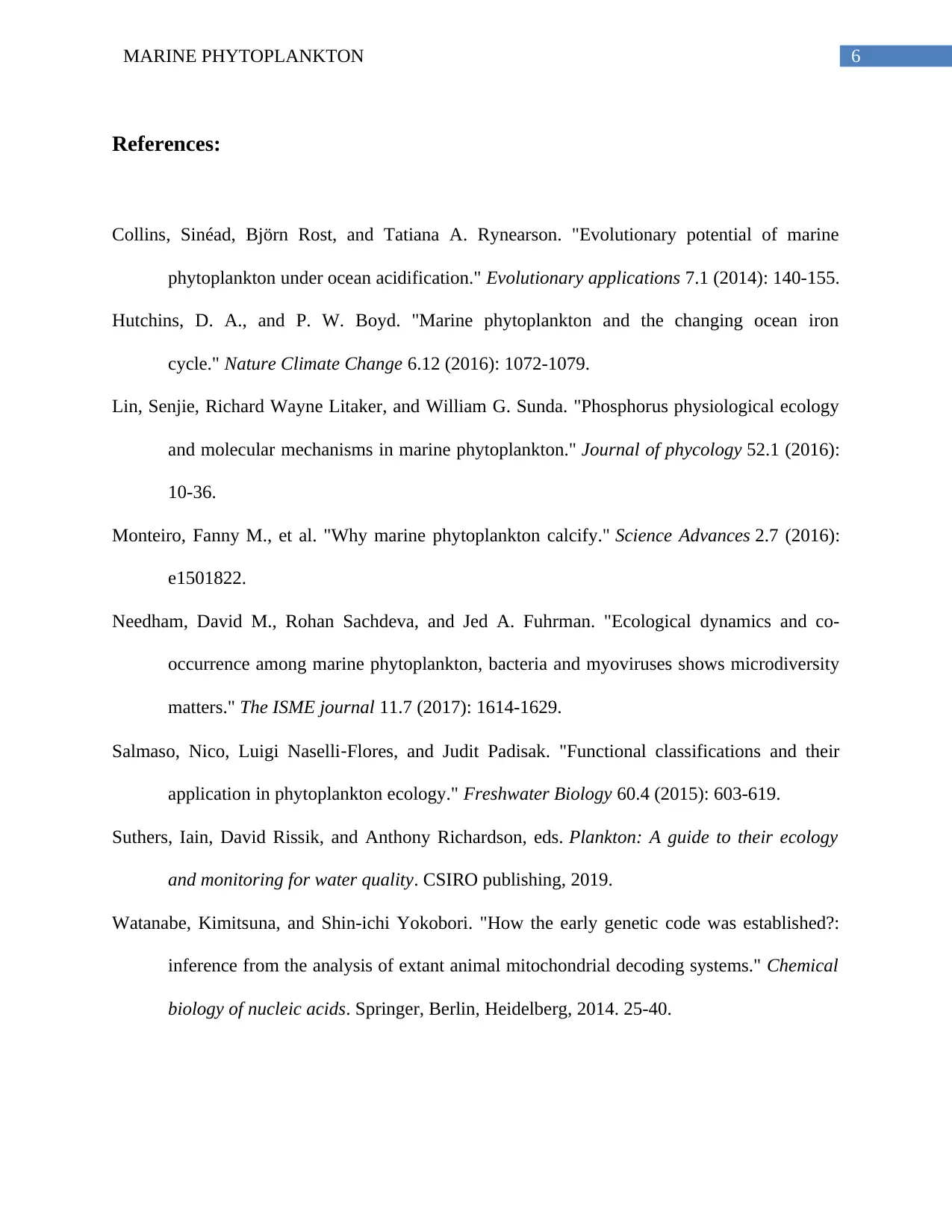
6MARINE PHYTOPLANKTON
References:
Collins, Sinéad, Björn Rost, and Tatiana A. Rynearson. "Evolutionary potential of marine
phytoplankton under ocean acidification." Evolutionary applications 7.1 (2014): 140-155.
Hutchins, D. A., and P. W. Boyd. "Marine phytoplankton and the changing ocean iron
cycle." Nature Climate Change 6.12 (2016): 1072-1079.
Lin, Senjie, Richard Wayne Litaker, and William G. Sunda. "Phosphorus physiological ecology
and molecular mechanisms in marine phytoplankton." Journal of phycology 52.1 (2016):
10-36.
Monteiro, Fanny M., et al. "Why marine phytoplankton calcify." Science Advances 2.7 (2016):
e1501822.
Needham, David M., Rohan Sachdeva, and Jed A. Fuhrman. "Ecological dynamics and co-
occurrence among marine phytoplankton, bacteria and myoviruses shows microdiversity
matters." The ISME journal 11.7 (2017): 1614-1629.
Salmaso, Nico, Luigi Naselli‐Flores, and Judit Padisak. "Functional classifications and their
application in phytoplankton ecology." Freshwater Biology 60.4 (2015): 603-619.
Suthers, Iain, David Rissik, and Anthony Richardson, eds. Plankton: A guide to their ecology
and monitoring for water quality. CSIRO publishing, 2019.
Watanabe, Kimitsuna, and Shin-ichi Yokobori. "How the early genetic code was established?:
inference from the analysis of extant animal mitochondrial decoding systems." Chemical
biology of nucleic acids. Springer, Berlin, Heidelberg, 2014. 25-40.
References:
Collins, Sinéad, Björn Rost, and Tatiana A. Rynearson. "Evolutionary potential of marine
phytoplankton under ocean acidification." Evolutionary applications 7.1 (2014): 140-155.
Hutchins, D. A., and P. W. Boyd. "Marine phytoplankton and the changing ocean iron
cycle." Nature Climate Change 6.12 (2016): 1072-1079.
Lin, Senjie, Richard Wayne Litaker, and William G. Sunda. "Phosphorus physiological ecology
and molecular mechanisms in marine phytoplankton." Journal of phycology 52.1 (2016):
10-36.
Monteiro, Fanny M., et al. "Why marine phytoplankton calcify." Science Advances 2.7 (2016):
e1501822.
Needham, David M., Rohan Sachdeva, and Jed A. Fuhrman. "Ecological dynamics and co-
occurrence among marine phytoplankton, bacteria and myoviruses shows microdiversity
matters." The ISME journal 11.7 (2017): 1614-1629.
Salmaso, Nico, Luigi Naselli‐Flores, and Judit Padisak. "Functional classifications and their
application in phytoplankton ecology." Freshwater Biology 60.4 (2015): 603-619.
Suthers, Iain, David Rissik, and Anthony Richardson, eds. Plankton: A guide to their ecology
and monitoring for water quality. CSIRO publishing, 2019.
Watanabe, Kimitsuna, and Shin-ichi Yokobori. "How the early genetic code was established?:
inference from the analysis of extant animal mitochondrial decoding systems." Chemical
biology of nucleic acids. Springer, Berlin, Heidelberg, 2014. 25-40.
1 out of 7
Your All-in-One AI-Powered Toolkit for Academic Success.
+13062052269
info@desklib.com
Available 24*7 on WhatsApp / Email
![[object Object]](/_next/static/media/star-bottom.7253800d.svg)
Unlock your academic potential
© 2024 | Zucol Services PVT LTD | All rights reserved.
